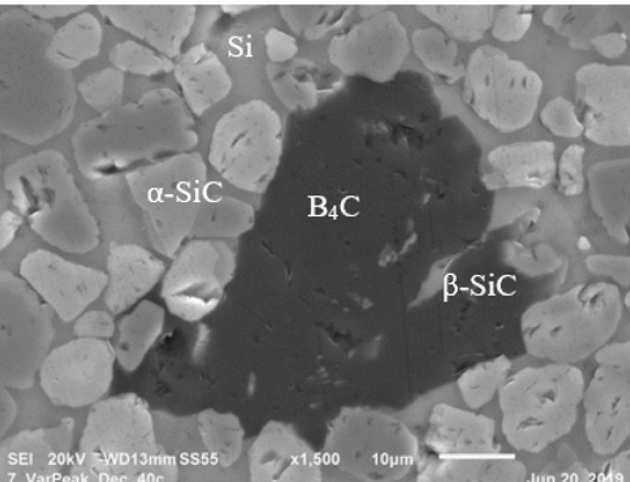Environmental barrier coatings for jet engines application
Research Fellow: Nasrin Al Nasiri
Mentor: Prof Eduardo Saiz
Sponsors: Rolls-Royce and Imperial College London
The need to increase the cycle efficiency and reduce noise and NOx emissions from engines has promoted the development of ceramic matrix composites (CMC) such as silicon carbide (SiC-SiC). The use of CMCs will lead to a significant improvement in fuel consumption and weight savings of up to 30% compared to Ni-based super alloys.
Si-based ceramics have excellent oxidation resistance due to formation of a protective silica layer on reacting with dry air. However, the same silica layer will react with water vapour to form gaseous silicon hydroxide, leading to high recession and component failure. To avoid this behaviour, a prophylactic environmental barrier coating (EBC) is required. A variety of EBCs have been developed in the past consisting of a minimum of 4 layers requiring a costly application method such as plasma spraying. The main aim of the work is to develop a reliable single layer of EBC, develop a low cost applying method and studying the corrosion behaviour.
We have selected four rare earth monosilicates as promising EBCs based on their thermal performance: Erbium (Er), Yttrium (Y), Ytterbium (Yb) and Lutetium (Lu). We have developed a patented wet processing technique to apply water-based RE-oxides on CMC samples previously oxidised in dry air to produce protective SiO2 layer. The samples are subsequently fired to promote reactive sintering and adhesion. The advantages of this non-line of sight method are: 1) it provides better adhesion, 2) it is a low cost and easy to use method, 3) it can be applied to any complex shape and size and 4) it has 100% powder efficiency leading to dramatic cost savings in coating materials. This new coating technology will lead at least to the following advantages: 1- Operational savings (10-15% higher fuel efficiency), 2- Production savings (up to $100K per engine) and 3-Reduction of emissions by 25-30%. This will result in more efficient, lighter, faster, cheaper, less noisy and less polluting gas turbines.
PhD Student: Kareem Abdelhadi
Silicon Carbide ceramics exhibit high temperature oxidation behavior. This make them promising candidates for the gas turbine hot section. However, at high temperatures, and water vapour, SiO2 layer becomes unstable and volatilize. This limits the operating temperature of gas turbines. To increase gas turbine efficiency, and limit carbon emissions, higher combustion temperatures are needed. Thus, Environmental Barrier Coatings (EBC) are required to protect SiC substrate from degradation, and recession. Rare-Earth (RE) EBCs have been identified as ideal candidates, but they are susceptible to hot corrosion in the combustion environment, and hence their durability is limited. My research aims to understand the following (a) oxidation behaviour of Reaction Bonded SiC-B4C (RBSBC), and (b) the corrosion behaviour of RE-oxide EBCs (Yb, Er, and Lu silicates) processed on RBSBC using dip coating. The thermochemical and thermomechanical behaviour of RE-EBCs are investigated under hot corrosion environment simulating the corrosive conditions in gas turbine hot section. Characterization using Scanning Electron Microscope equipped with Energy Dispersive Spectroscopy, X-Ray Diffraction, Transmission Electron Microscopy, and Raman spectroscopy are used to develop modelling methodology to predict the life and durability of EBCs and understand its corrosion, and fracture, behavior.

PhD Student: Willliam Wei
William’s project aims to study the adhesion strength of environmental barrier coatings (EBCs) applied on silicon carbide (SiC) ceramic matrix composites (CMCs) to develop the next generation of gas turbines that are faster, cheaper, lighter, more efficient and less pollutant. And he is currently working on two areas;
● Developing mechanical testing methodologies that will enable an accurate and reliable characterization of the adhesion strength at the coating/CMC interface using the single layer approach.
● Combining systematic mechanical testing and structural characterization in order to develop a deep understanding of the parameters that control adhesion, delamination, spallation and the models needed to support the design of new materials.


